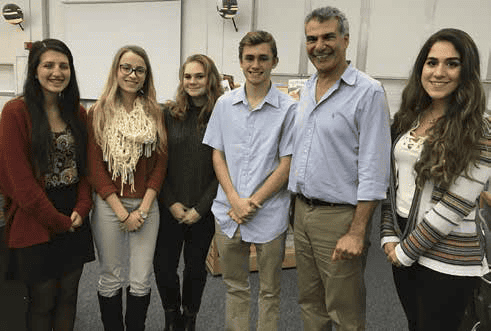The Middle East is a place where one plus one rarely equals two. Rather, it is a multifaceted and extraordinarily complicated region that has experienced escalated turbulence and dramatic change. To maneuver through this Middle East confusion, one almost needs a map. That’s where Avi Melamed comes in.
Melamed is an acclaimed former Israeli intelligence analyst and expert on current affairs in the Arab and Muslim world. Fluent in Arabic, he has held senior government, intelligence and counter terrorism positions, is an educator and lecturer and is the author of Inside the Middle East.
On Tuesday, Nov. 15, in a jam-packed room at the Reba and Sam Sandler Family Campus, Melamed provided insight into the psyche of the Arab world. He highlighted the major players and historical conflicts that are crucial to understanding the Middle East, while offering a fearful, yet hopeful, outlook for the future.
Speaking frankly, Melamed highlighted two major historical struggles that have created centuries-long tension and rift: The Sunni-Shiite conflict and Iranian-Arab power struggle.
“These conflicts have shaped and continue to the shape the Middle East,” Melamed said, as he explained how the Israeli-Palestinian conflict has created an unprecedented bond between Iranians and other Sunni Arab groups, such as Hamas and Hezbollah. He also noted that Middle East conflicts are causing the Israeli-Palestinian conflict—not the other way around. In addition, Melamed broke down different political groups of Islam, focusing on Militant Islam, known to the world through groups such as ISIS and Al Queda. “Militant Islam is here to stay,” he noted, “because the conditions that created it are still here.”
“And I thought Jews had long memories!” says Kevin Lefcoe, chair of the Community Relations Council of the United Jewish Federation of Tidewater’s Israel Education and Advocacy committee. “Avi’s explanation of the division of the Sunnis and Shiites over 1,300 years ago provided me an understanding of the internal conflict raging for Muslims today. His visual presentation of the world map from Morocco to Iran depicted the swath of war ravaged areas, whose path includes the Land of Israel. This is important information that gives me a better perspective on the political, religious and radical elements of Israel’s dark neighbors, including the factions that seek to do us harm.”
Why is this important? As Samantha Golden, a graduate student of International Studies at Old Dominion University says, “The sectarian landscape of the Middle East is highly nuanced and complex. It is never as black and white as Islam vs. the West, Israelis vs. Palestinians, or Sunnis vs. Shiites. A greater knowledge of the region is necessary for addressing local and global concerns like terrorism with pragmatism rather than fear.”
When asked what U.S. influence can do to impact the Middle East, Melamed paused and responded, “It is a lose-lose situation. U.S. policies can contribute, but it is the bitter fruits of the longstanding problems within Muslim society that created the problem, and changes must be made there to solve it.”
-Raizy Cook

